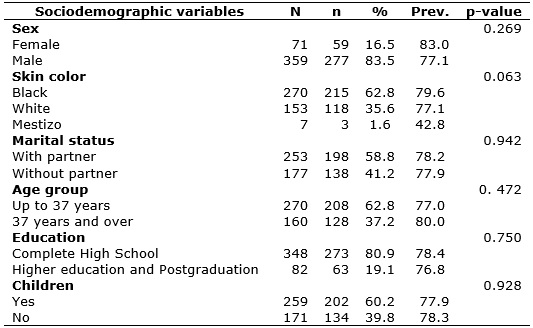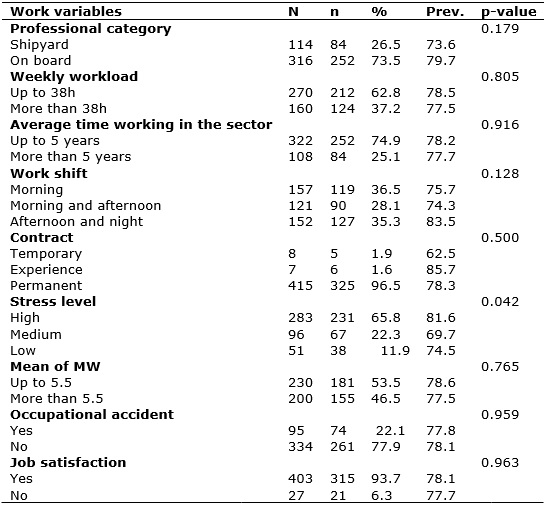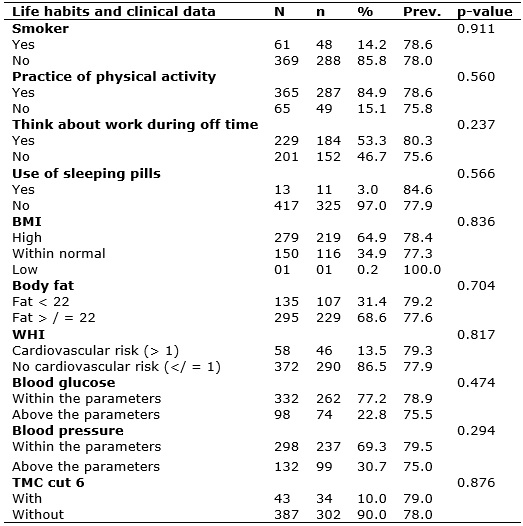
Legend: N = total in the stratum; n = number of workers with suspicion of BS; Prev. = prevalence.
ORIGINAL RESEARCH
Prevalence of Burnout Syndrome among waterway workers
Jorge Luiz Lima da SilvaI; Ândrea Cardoso de Souza II; Rafael da Silva SoaresIII; Enéas Rangel TeixeiraIV; Felipe dos Santos CostaV; Marcelle Belarmino Dal Bello de OliveiraVI
IPhD in Public Health. Adjunct Professor, Fluminense Federal University.
Niterói, Rio de Janeiro, Brazil. E-mail: jorgeluizlima@gmail.com
IIPhD in Public Health. Adjunct Professor, Fluminense Federal University.
Niterói, Rio de Janeiro, Brazil. E-mail: andriacsouza@gmail.com
IIIMaster in Healthcare Sciences. Nurse, Fluminense Federal University.
Niterói, Rio de Janeiro, Brazil. E-mail:
rafaeldasilvasoares@hotmail.com
IVPhD in Nursing. Full Professor, Fluminense Federal University. Niterói, Rio
de Janeiro, Brazil. E-mail: eneaspsi@hotmail.com
VMaster student of the Graduate Program in Collective Health, Fluminense
Federal University. Niterói, Rio de Janeiro, Brazil. E-mail:
felipedosantoscosta@gmail.com
VIResident in Nursing, State University of Rio de Janeiro, Brazil. E-mail:
marcellebdalbello@gmail.com
DOI: https://doi.org/10.12957/reuerj.2018.26131
ABSTRACT
Objective: to describe the prevalence of suspected Burnout Syndrome among workers, and to analyze possible associated factors. Method: the subjects of this cross-sectional observational study were 430 employees of a water transport company in Rio de Janeiro state. Burnout was identified using the Maslach Burnout Inventory, and its prevalence measured on the criteria of Grunfeld et al. The study was approved by the Antônio Pedro University Hospital research ethics committee (CAAE55109216.4.0000.5240). Results: suspected Burnout Syndrome was observed in 336 workers (78.1% prevalence), which is a considerable value. Conclusion: the syndrome was observed to present as a possible complication of work organization, independently of several study variables present.
Descriptors: Occupational health; burnout professional; occupational health nursing.
INTRODUCTION
Stress phenomenon is a current problem and the object of multiprofessional research in several areas due to its consequent risks for the balance of human health1.
In the last decades, the demand for increasing productivity and several other factors have generated a greater occupational stress, that is, stress related to work. Like other forms of stress, occupational stress increases the incidence of illnesses in the population, although a healthy lifestyle seems to mitigate this risk. Burnout Syndrome (BS) is the extreme emotional response to chronic occupational stress2.
One aspect to be considered at present is the magnitude of psychosocial aspects represented, to a great extent, by stress in modern society. The understanding of the morbid processes provoked by the exhausting factors in the work environment has been sought3. Work-related social conditions and psychological stress are increasingly seen as occupational risk factors that affect practically the entire economically active population4, as well as work under tense climates, lack of job security, or even risks of work accidents. These are determining factors for the development of the problem, which can have consequences at individual, professional, family and social levels5.
This study aimed to describe the prevalence of suspected BS among waterway workers, analyzing the possible associated factors. A contribution of the study is the possibility to deepen the knowledge of workers in this area about BS warning signs, which may favor early interventions and avoid health problems.
THEORETICAL FRAMEWORK
The term burnout means self-burn or wearing and is used to characterize a set of symptoms that are predominantly evident among professionals who deal with people in the work environment, and who complain of physical and mental exhaustion, irritability, loss of interest in work, and feelings of self-deprecation6. This is a situation that affects, with ¼ fold higher frequency, people who keep direct and continuous contact with other human beings as usual activity of their profession 7. The disease can be seen as a protection factor, but represents a risk of dehumanization, constituting the interpersonal dimension of BS5.
When it comes to workers in the waterway sector, research is scarce and focused in the area of work safety, hazardous conditions, work accidents and sleep deprivation8. The psychic changes experienced by these workers can harm them in terms of social life and also affect the quality of the activities they developed. Balance in the work environment is essential to avoid or reduce illnesses caused by occupational stress9. The present study addresses the prevalence of suspected BS among waterway workers.
It is well known that a significant part of society is unaware of the importance of well-being, both for mental and physical health. The workplace significantly influences the degree of personal fulfillment and the possibility of the onset of stress and risk of BS caused by environments that put pressure on workers5. It is observed that the BS has negative consequences related to individual, professional, family, social and institutional spheres. Workers may lose the ability to readapt to the existing demands in the work context6.
METHODOLOGY
This is a cross-sectional observational study. The participants of the survey were employees of a waterway transportation company located in the state of Rio de Janeiro. The facilities of the administrative sector, shipyard and vessels/waterways of this company were the scenario of this research. Data collection took place during the year 2012.
The inclusion criteria for participants were as follows: employee of the company with formal employment bond, and aged over 18 years. Employees who had worked for less than three months in the company were excluded.
To avoid the bias of healthy workers, the list of employees on sick leave was requested from the occupational medical sector for active search and telephone contact. Six people in this situation and were included in the study. The total sample, at the end of the collection, gathered 430 workers.
The instrument used was a self-administered questionnaire, whose filling could have the help of a researcher, when necessary. Aspects related to sociodemographic characteristics were: self-reported skin color; sex; age; schooling; marital status; number of children; and per capita family income in minimum wages.
Regarding labor aspects, the studied variables were: professional category; number of jobs; work shift; weekly workload; average time in the work; and type of employment bond. Regarding health and lifestyle, the following variables were investigated: smoking; use of sleeping pills; the habit of thinking about work during the time off; body mass index; glycemic values; body fat index, waist/hip ratio, blood pressure and diagnosis of diabetes and if presence of current health treatments.
The Maslach Burnout Inventory (MBI), in its version adapted and validated to Portuguese with nursing professionals, was used for the assessment of BS. The instrument consists of 22 Likert-type questions with values ranging from one (never) to five (always), evaluating three dimensions: emotional exhaustion (EE) - nine statements; depersonification (DE) - five statements; and personal fulfillment (PF) - eight statements10.
After review and coding, data were transcribed to spreadsheets through independent double typing. Errors and inconsistencies were checked through a process of reviewing and auditing the data. The database was built using the Statistical Package for the Social Sciences (SPSS) version20.
The results were represented by measures of central tendency - mean and standard deviation - and treated through the chi-square association test (x2) to verify differences between the groups studied in the bivariate analysis. Significance was considered when p ≤ 0.05. Prevalence of BS was observed according to criteria described in the literature11.
The research project was approved by the Ethics Committee of the Antônio Pedro University Hospital under number 260/11, in compliance with Resolution nº 196/96.
RESULTS
Prevalence of BS was observed, according to Grunfeld and collaborators' 11 criteria, in 336 workers (78.1%), which id a considerably high proportion. This more sensitive criterion takes into account the fact that when one of the dimensions of the Maslach Model presents an unfavorable score, this indicates reasons for suspicion1.
Sociodemographic aspects
Regarding the sociodemographic aspects, among the total number of employees participating in this study, 359 (83.5%) were male; 259 (60.2%) had children; 270 (62.8%) were aged up to 37 years; 348 (80.9%) had completed high school; 153 (35.6%) declared themselves white, 270 (62.8%) black, and 07 (1.6%) mestizo; and 253 (58.8%) had a marital relationship, as shown in Table 1.
TABLE 1:
Prevalence of suspicion of BS according to sociodemographic variables among
waterway professionals in the State of Rio de Janeiro, 2016.

Legend: N = total in the stratum; n = number of workers with suspicion of
BS; Prev. = prevalence.
Labor aspects
Regarding the labor aspects, 316 (73.5%) participants worked on board; 157 (36.5%) work in the morning shift, 121 (28.1%) in business hours - morning/afternoon - and 152 (35.3%) in the afternoon/night shift; 322 (74.9%) reported having up to 5 years of work in the sector; 415 (96.5%) had a permanent employment bond; 270 (62.8%) had work load varying up to 38 hours per week; 283 (56.8%) were submitted to a high level of stress; 230 (53.5%) received up to 5.5 minimum wages; and 403 (93.7%) reported being satisfied at work. This information is shown in Table 2.
Table 2:
Prevalence of suspicion of BS according to work variables among waterway
professionals in the State of Rio de Janeiro, 2016.

Legend: N = total in the stratum; n = number of workers with suspicion of
BS; Prev. = prevalence.
Life habits and clinical data
Regarding lifestyle and clinical data, 369 (85.9%) did not use tobacco; 229 (53.2%) reported thinking about work during their time off; 417 (97%) did not use sleeping pills; 279 (64.8%) had a body mass index above the recommended level; 295 (68.6%) had high body fat levels (22% of the total body weight); 372 (86.5%) had adequate waist/hip ratio (WHI); 332 (77.2%) had blood glucose levels within the parameters of normality; and 298 (69.3%) had blood pressure levels within recommended parameters, as described in Table 3.
Table 3:
Prevalence of suspicion of BS according to life habits and clinical data
variables among waterway professionals in the State of Rio de Janeiro,
2016.

Legend: N = total in the stratum; n = number of workers with suspicion of
BS; Prev. = prevalence.
DISCUSSION
In this study, the prevalence of suspicion of BS11 was 336 (78.1%). In comparison, the overall prevalence among university teachers was described as 17.6%12, among primary health care professionals (physicians and nurses) was 17.1%12, and among intensive care unit nurses was 15.4% 13.
No studies were found on the association between BS and the professionals interviewed. However, according to the existing studies, the professionals most susceptible to BS syndrome are those who work in the healthcare area, those who constantly and directly provide services to the population, such as health and education professionals14. Waterway workers have direct contact with their customers when providing their services and their work pose adverse conditions and risks of accidents.
However, we observed that most of these professionals were satisfied with their work. A total of 403 participants were satisfied with their work activities and also presented a higher prevalence of suspicion of BS (78.1%). The fact that these professionals feel satisfied with their work suggests that they consider their activities to be challenging, although working conditions were partially adequate15, in addition to resilience capacity.
Waterway professionals with high levels of stress were suspicious of BS in 81.6%. BS is a special type of occupational stress that is characterized by a deep feeling of frustration and exhaustion linked to the work performed a feeling that can be gradually extend to other areas of daily life 16. Thus, the greater the stress, the more exposed the professional is to the outcome investigated17.
The suspicion of prevalence of BS was higher among women than men, which is in line with studies that show the female gender to be associated with higher rates of emotional exhaustion18.
Workers with partners prevailed. This group requires a form of dedication and level of affection with which they take on a multiplicity of functions - being a husband/wife, housewife, child-rearing, multiple employment bonds and other activities19.
A larger number of workers with suspicion of BS were observed in the nighttime shift, more than other shifts. The night shift can negatively impact the health and well-being of waterway workers due to disturbances in the normal biological rhythm, break in social and family ties, and also problems for physical health, sleep disorders and eating disorders 20.
Therefore, we noticed that some more frequent characteristics among the individuals with suspicion of BS, including female gender, presence of partner and work in night shifts. Moreover, the literature mentions that nocturnal rest after work may be impaired among women and this is specially intensified when they have children21.
Regarding the time of experience working in the sector, workers with less time had a higher prevalence of suspicion of BS than those who were more experienced. The first are likely professionals who are not very resilient and who feel the pressure in their daily work.
Greater suspicion was found in the group of smokers. Tobacco can be considered a source of relief, and it is therefore more consumed, besides other factors, such as lifestyle and personal, socioeconomic and environmental characteristic, but it can bring negative consequences in long run22.
There was greater suspicion of BS among workers who think about work during leisure time (80.3%). This association has also been identified in another research with intensive care nurses (p = 0.009)1.
CONCLUSION
The prevalence of suspicion of BS among waterway workers was significant when compared to studies with other populations. This finding, in terms of prevalence, shows the dimension of the outcome over the group studied. We verified that BS represented a possible complication related to the work organization, independent from several variables investigated.
It is possible to identify stress in the professionals interviewed. Yet, most of them were at high levels of tension and, consequently, in suspicion of BS, which is a phenomenon known as the response to chronic stress.
Signs of mental illness need more attention from health professionals, especially among the most vulnerable groups that need to provide constant attention to the public and deal with people, as they work in contexts of high requirements and diverse demands.
The expected impacts of this study were: incentive to self-care and adoption of better habits and lifestyles; adherence of the population to preventive practices and promotion of health care; and effective contributions to nursing teaching and care, within the scope of care for human groups.
The results of the research were returned to the participants, as well as educational actions such as: lectures; distribution of educational material; raising of awareness about BS and its symptoms, and stimuli to the adoption of healthy life habits. The actions were carried out in partnership with the company's management and the occupational medical sector. Thus, nursing shared in the area of worker health, even in an occupational health scenario, involving the main stakeholders, that is, the professionals who could express their opinions, ask questions, and indicate topics for future interventions.
REFERENCES
1.Silva JLL, Soares RS, Costa FS, Ramos DS, Lima FB, Teixeira LR. Psychosocial factors and prevalence of burnout syndrome among nursing workers in intensive care units. Rev. bras. ter. intensiva. 2015; 27(2): 125-33.
2.Prosdócimo ACG, Lucina LB, Olandoski M, Jobs PMJ, Schio NA, Baldanzi FF, et al. Prevalence of Burnout syndrome in patients admitted with acute coronary syndrome. Arq. bras. cardiol.(Online) 2014; 104(3): 218-25.
3.Alcântara VCG, Silva RMRCA, Pereira ER. The working conditions and the lifeworld of bus drivers: phenomenological study. Rev. enferm. UERJ. 2016;24(6):e12514.
4.Silva JLL, Teixeira LR. Psychosocial aspects and Burnout syndrome among intensivist nursing workers.Rev. baiana saúde pública. 2015; 39(1):182-5.
5.Oliveira FKF, Coutinho MS, Pinheiro FGMS. Burnout syndrome in nursing professionals from a large emergency department in Sergipe. Interfaces Cient. – Saúde e Amb. 2015;3(3): 49-64.
6.Tavares KFA, Souza NVDO, Silva LD, Kestenberg CCF . Prevalence of Burnout syndrome among resident nurses. Acta paul. enferm. 2014; 27(3): 260-5.
7.Maslach C, Jackson SE. The measurement of experienced Burnout. J. organ. behav. 1981;2(2): 99-113.
8.Carvalho MM. Life and work of seafarers on board the offshore sector [dissertation]. Rio de Janeiro: Fundação Oswaldo Cruz; 2010.
9.Santos PG, Passos JP. Stress and Burnout syndrome in nurses working in emergency care units. Rev. pesqui. cuid. fundam. (online). 2012; 3(supl 1):671-5.
10.Tamayo MR, Tróccoli BT. Construction and factorial validation of the Burnout Characterization Scale (ECB). Estud. psicol. 2009; 14(3):213-21.
11.Grunfeld E, Whelan TJ, Zitzelsberger L, Willan AR, Montesanto B, Evans WK. Cancer care workers in Ontario: prevalence of Burnout, job stress and job satisfaction. CMAJ. 2000; 163(2): 166-9.
12.Costa LST, Gil-Monte PR, Possobon RF, Ambrosano GMB. Prevalence of Burnout syndrome in a sample of brazilian university professors. Psicol. reflex. crit. 2013; 26(4):636-42.
13.Mata C, Machado S, Moutinho A, Alexandra D. PreSBurn study: prevalence of burnout syndrome in primary care professionals. Rev. port. med. geral fam. 2016; 32(3):179-86.
14.Melo EMVB, Santos RLN, Cavalcante CAT, Siqueira DG, Medeiros LP, Sousa DA. Prevalence of Burnout Syndrome in the ICU on Nurses of a Hospital School of Recife. Id on Line Rev. M. Psicol. 2014; 8(24):127-36.
15.Ribeiro LCC, Barbosa LACR, Soares AS. Evaluation prevalence of burnout among public school teachers and their relationship to sociodemographic. Rev. enferm. Cent.-oeste min. 2015; 5(3):1741-51.
16.Andolhe R, Barbosa RL, Oliveira EM, Costa ALS, Padilha KG. Stress, coping and Burnout among intensive care unit nursing staff: associated factors. Rev. Esc. Enferm. USP. 2015; 49(spe): 57-63.
17.Silva JP, Damásio BF, Melo AS, Aquino TAA. Stress and Burnout in Teachers. Rev. fórum identidades. 2008; 3(3):75-83.
18.Oliveira EB, Gallasch CH, Silva Junior PPA, Rodrigues AVR, Valério RL, Dias LBS. Occupational stress and Burnout in nurses of an emergency service: the organization of work. Rev. enferm. UERJ. 2017; 25:e28842.
19.Beltrán CA, Salas JHB, Paredes JJR, Zárate LAQ, Cabrales APC, Ortega GG, et al. Psychosocial variables and Burnout syndrome in general physicians in Tepic, Nayarit. Salud UNINORTE. 2015; 31(2):245-54.
20.Santana RS, Brito BAM, Ferreira JLS, Silva AFL, Cunha MB, Viana LVM. Influence of night work on quality ICU nursing team life. R. Interd. 2015; 8(2): 25-34.
21.Santos AA, Costa O. Quality of life at work of the nursing professionals who work on the night shift in a teaching hospital in the south of Minas Gerais. Rev. Ciênc. Saúde. 2016; 6(1):43-51. 22.Vargas LM, Redkva PE, Cantorani JRH, Gutierrez GL. Lifestyle and associated factors in physical education undergraduate students. Rev. de Atenção à Saúde. 2015; 13(44):17-26.